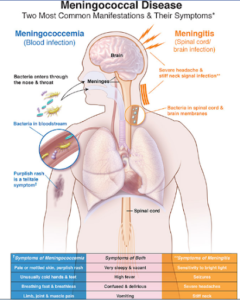In news– Recently, the Democratic Republic of the Congo has declared an outbreak of meningitis in the north-eastern Tshopo Province.
About meningitis-
- Meningitis is an inflammation of the meninges.
- The meninges are the three membranes that cover the brain and spinal cord.
- The most common causes of meningitis are viral and bacterial infections.
- The symptoms include altered mental status, nausea, vomiting, sensitivity to light, irritability, headache, fever, chills, stiff neck, purple areas of skin that resemble bruises, lethargy.
- The infections is usually caused by the bacterium Neisseria meningitidis (also termed meningococcus).
- Neisseria meningitidis infects only humans and there is no animal reservoir.
- The bacteria are transmitted from person-to-person through droplets of respiratory or throat secretions from carriers.
- The largest burden of meningococcal disease occurs in an area of sub-Saharan Africa known as the meningitis belt, which spans 26 countries and stretches from Senegal in the west to Ethiopia in the east.
- During the dry season, dust winds, cold nights and upper respiratory tract infections damage the nasopharyngeal mucosa, increasing the risk of meningococcal disease.
- Transmission of Neisseria meningitidis can be facilitated by overcrowded housing arrangements and gatherings.
Prevention & global efforts-
- Meningitis is a largely preventable disease through vaccination.
- In November 2020 ‘Defeating Meningitis by 2030’ global road map was approved by the World Health Assembly with three objectives:
- End of bacterial meningitis epidemics.
- Reduction of cases of vaccine-preventable bacterial meningitis by 50 per cent and deaths by 70 per cent.
- Reduction of disability and improvement of quality of life after meningitis due to any cause.
- A meningococcal A conjugate vaccine (MenACV) was introduced through mass preventive campaigns since 2010.
- Routine immunisation programmes have started since 2016.

















